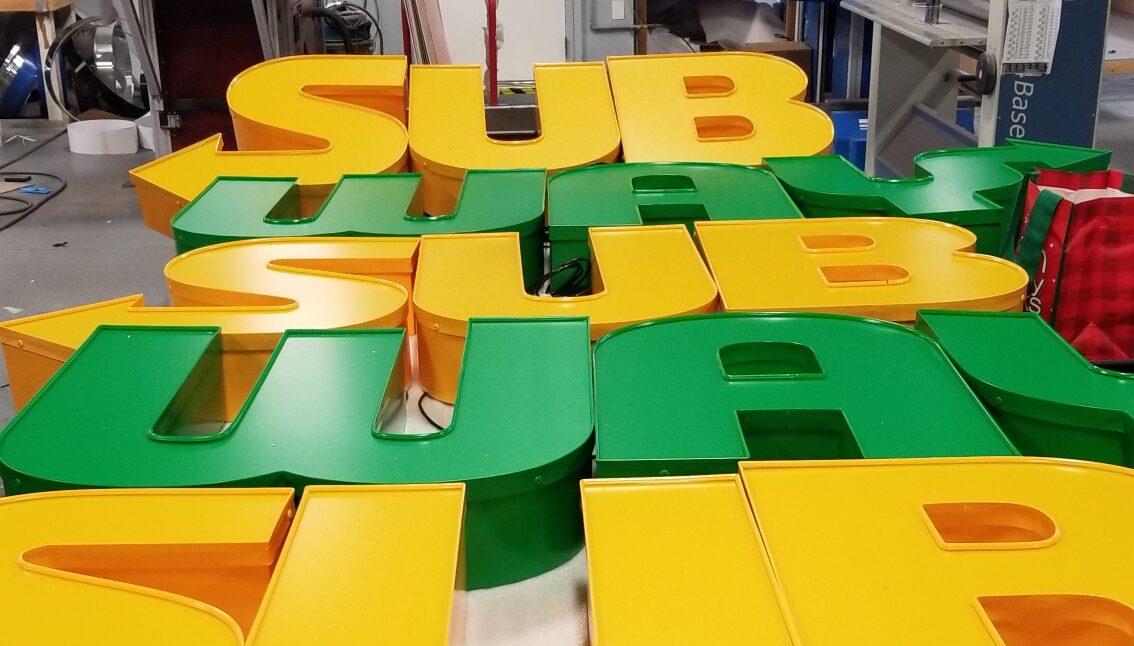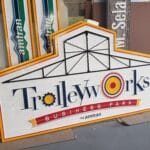Channel Letter Wholesale Sign Manufacturing: Cost Vs. Capabilities
One of our National Accounts recently awarded Hanson Sign Companies one-third of the wholesale sign manufacturing work for a major, national mobile phone company’s sign change-out. This allowed us to invest in new equipment and personnel to expand our capacity. As we explored our options for channel letter bending equipment, the choices narrowed to two industry-leading competitors that both make great products and have excellent reputations. In one camp, we had a recently re-engineered, heavy-duty, reliable, and highly productive machine. While not cheap by any measure, we could obtain it for one-third of the lower cost of the second option. The second option was just as fast and reliable, although it takes slightly longer to adjust when a change to produce a flange is desired. For the extra money, it provides the ability to produce the highest quality, smaller, lower profile, and trim-less channel letters.
The dilemma we faced was that we had some discussions with and inquiries from customers, but no orders or real, demonstrable demand for trim-less and lower profile letters to date. Of course, we had never pushed or marketed the idea either. The lower-cost option could pump out high-quality, traditional letters and pay for itself more quickly based on current demand.
Oh, did I mention, the more expensive machine runs traditional coil for traditional letter,s but to make the trim-less versions we would need to buy a proprietary, patented coil from the machine manufacturer at nearly three times the cost of traditional. Conversely, we already have the base model from the costlier supplier in service, we have been happy with the machine and service, and our team is trained and familiar with its operation and support staff.
Growing Trends in the Channel Letter Industry
There are currently three rapidly growing trends in the channel letter industry.
Highlights from an article by James Cross in the December 2016 issue of Sign Builder Illustrated helped in the decision-making process. James wrote the following:
“My position has taken me inside the fabrication plants of nearly all the major players in the national program arena… Being in this somewhat unique position permits me the opportunity to quickly ascertain current trends in our industry, identify future trends in channel letter manufacturing, and predict what fabrication challenges are likely to confront manufacturers.
Whether the challenges relate to equipment, materials, or techniques, my primary task is to determine what can be done to take advantage of these trends, overcome the obstacles they present, and help manufacturers turn opportunity into additional bottom-line dollars.
… There are currently three rapidly growing trends in the channel letter industry. Channel letters and logos are trending towards being smaller, low profile, and trimless.
The driving force behind these trends is typically commercial property entities or corporate branding experts, architects, and designers. … in airports, shopping centers, strip malls, franchise operations, and restaurants. The goal is to present a clean, sophisticated, identifiable, yet distinctively unique, image for their brand or facility.”
During our research, I spoke to James Cross personally, and he mentioned that the Simon Property Group now requires trimless channel letters in their properties. Then, before a recent long flight from Buffalo to Phoenix, for a combined vacation/work trip, my wife Lynn, purely by coincidence and without foreknowledge, picked up Fortune Magazine’s December 15th, 2016, edition for me to read on the plane. As I opened it up to the table of contents, my sight was drawn to “Reinventing the American Mall” (page 148) an article on the success of the nation’s largest mall empire – the Simon Property Group. As I read the story, I could not help but think James’ claim was legit, as the article notes, in one of Simon’s malls, “…as part of a $300 million overhaul… throughout the mall, tasteful signage steers you to the new luxury wing.” In the photo above the article, taken inside the mall, it appears all the channel letters are trim-less. Was this an omen?
Fabrication Process
Getting back to James Cross’ Sign Builder Illustrated article.
“… trim-less channel letters have been fabricated for years, but the process typically required unsightly fasteners to be driven through the walls of the return into the edge of very expensive, thick acrylic.
Investing in New Equipment
Companies are making significant investments in improved equipment, materials, processes, and techniques in channel letter fabrication
The traditional trim cap, which is the weakest link in the chain durability-wise, is eliminated entirely with trim-less material.
Trim-less letters also command a higher price due to their cleaner, more sophisticated appearance and the limited number of manufacturers with the ability to produce them.
Today, there are automated benders available… These are higher quality, precision-engineered machines incorporate such exacting tolerances that they can dramatically increase accuracy and nearly eliminate hand forming after the automated bending process is completed…capable of producing exceptionally crisp, accurate results like serifs measuring 3/16-inch in challenging materials like .063-inch aluminum…letters as small as 1 inch deep are now becoming common, where it was previously impossible to illuminate such shallow letters without shadows and hotspots.”
Weighing Capability Vs. Cost
While James made a strong case, I wanted to get input from my account executives, business partner, and customers to get their thoughts. One key player with a long-time customer who was formerly a distributor rep said, “You will never go wrong investing in the best equipment; it will give you an edge in the marketplace.” Another New York City based customer’s CEO told me “invest in the capability to make the best letters, it will separate you from all the cheap, crappy manufacturers out there. You can market that”. Andy, my business partner, also liked the idea of giving ourselves a quality edge that we can market.
The bottom line
James Cross stated in closing his article, “Manufacturers who embrace new methods, materials, and techniques are going to be the ones who reap the rewards offered by these new trends in the industry.”
My decision was made. We spent the extra money, reconfigured our production layout, moving screen printing up to the mezzanine level’s former storage loft, re-routed traffic flow from the office around production instead of through the middle, and opened the floor to make room for our second Channel letter line. Our new Super Channel Bender from Adams Tech arrived last Friday, The tech has been here training the team and getting us ready to go to the next level in Channel letters. The entire team is energized and ready to grow. The next step is training the sales team on our new offerings and developing the marketing communication to get the word out.
Ed Sullivan is the CEO of Hanson Sign Companies, which is a wholesale sign manufacturer. He formerly held positions as Director of Trade Marketing and then V.P. of Sales for Lactalis American Group’s Retail Dairy division, leading the sales effort to the largest retailers in the country.



